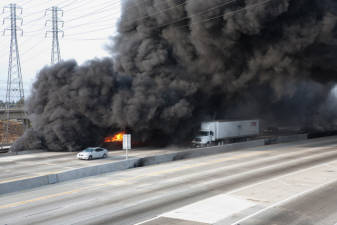Deeper spills, standing liquids and containers pose different requirements.
If the fuel, in deeper amounts, has been ignited and its entire volume heated, it may take some time before temperatures cool and the foam blanket controls vapor emissions.
Calculating
potential
Square footage by fuel volume-
The larger a fuel container the exponentially larger surface area of fuel when spilled. Gasoline tanker trucks range from 5-9,000 gallons, railcars may hold roughly 30,000 gallons and storage tanks vary depending on size.
1 gallon [US, liquid] = 231 cubic inches
1 gallon [US, liquid] = 0.13368055556 cubic foot
8 500 gallon [US, liquid] = 1,963,500 cubic inches
An 8,500 gallon gasoline tanker could produce 13,635 Ft2 (Square feet) of fluid 1" deep.
An 8,500 gallon gasoline tanker could produce 27,270 Ft2 (Square feet) of fluid 1/2" deep.
An 8,500 gallon gasoline tanker could produce 54,540 Ft2 (Square feet) of fluid 1/4" deep.
An 8,500 gallon gasoline tanker could produce 109,080 Ft2 (Square feet) of fluid 1/8" deep.
Using Application rate formulas, these larger fuel volumes can easily exceed our capabilities without massive mutual aid of foam concentrate, personnel & equipment.





